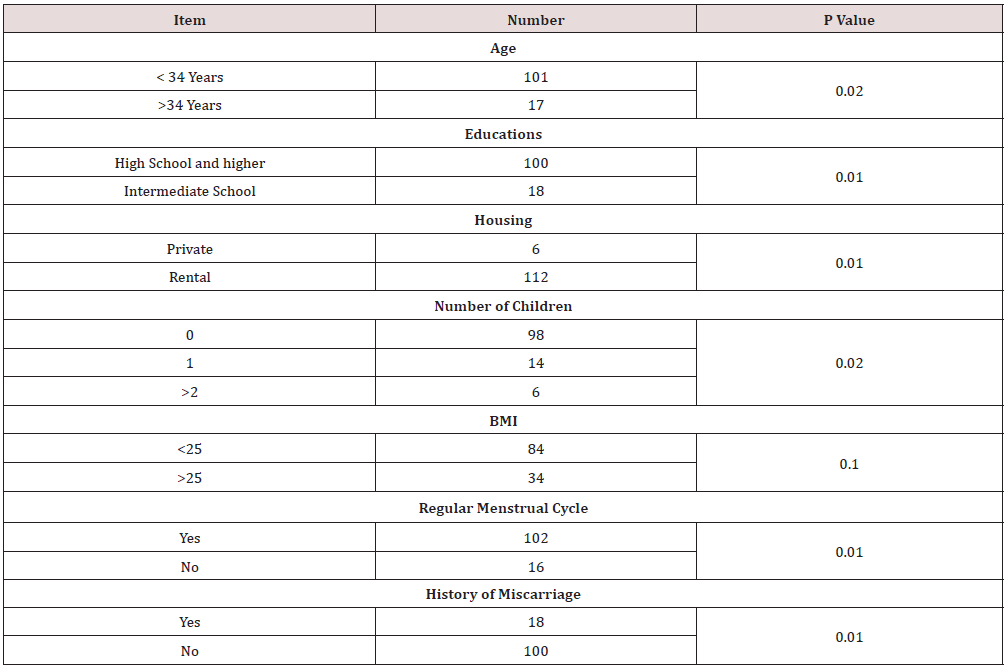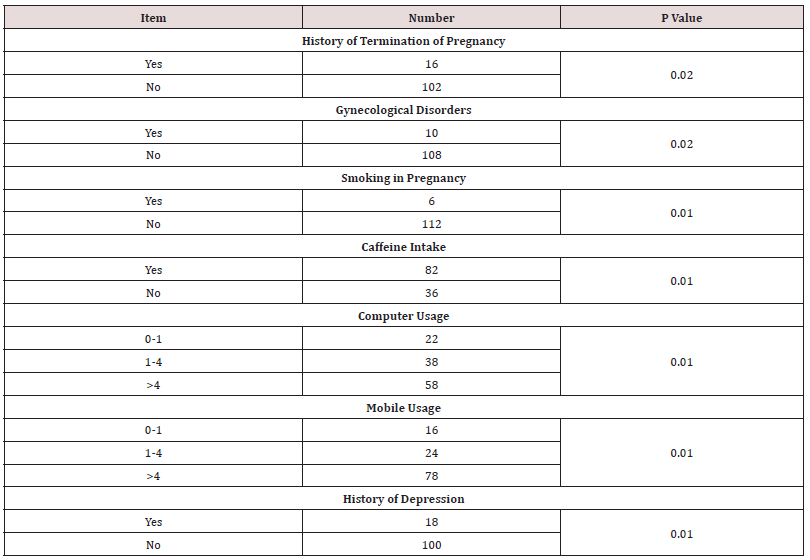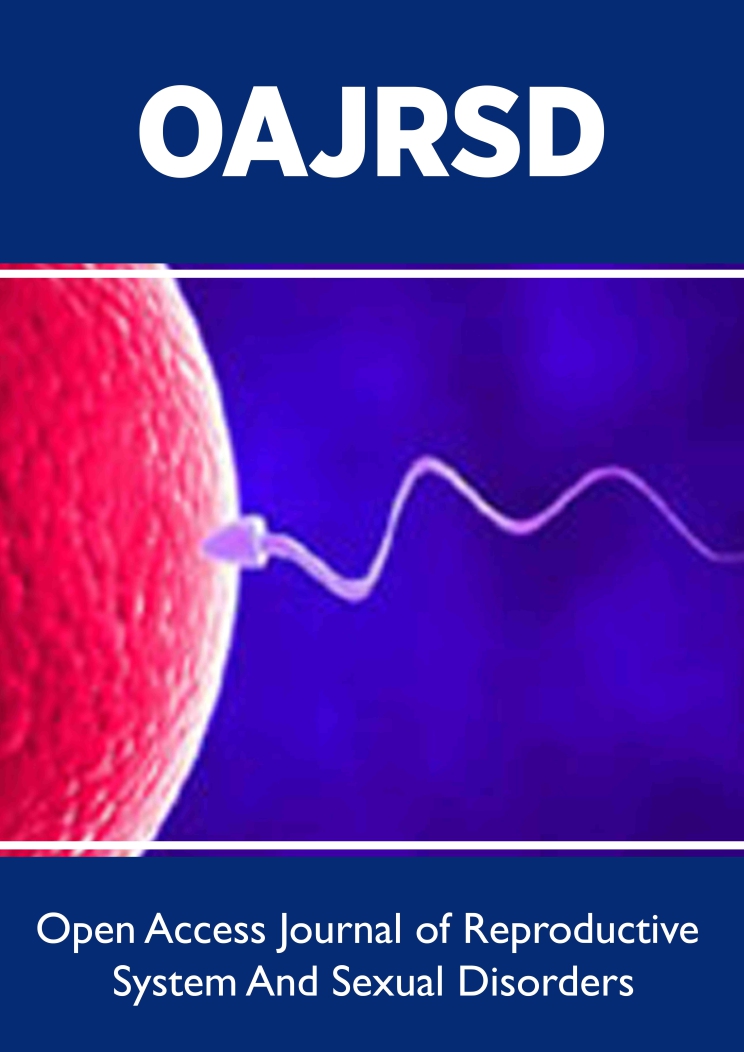
Lupine Publishers Group
Lupine Publishers
Menu
ISSN: 2641-1644
Research Article(ISSN: 2641-1644) 
The Effect of Pregnant Ladies Lifestyle on Pregnancy; Clinical Study in a Single Saudi Center Volume 1 - Issue 3
Muhammad Alsaddique1 and Ahmad Talal Chamsi2*
- 1,2 Department of Obstetrics and Gynecology, Security Forces Hospital, Riyadh, Saudi Arabia
Received: July 13, 2018; Published: July 19, 2018
Corresponding author: Ahmad Talal Chamsi, Department of Obstetrics and Gynecology, Security Forces Hospital, P.O. Box 3643, Saudi Arabia
DOI: 10.32474/OAJRSD.2018.01.000112
Abstract
Background: Complications in pregnancy are common and threatened miscarriage is occurring in approximately 20% of all pregnancies. The present study was conducted to determine various lifestyle factors leading to threatened abortion.
Materials & Methods: This study was conducted in the department of Gynecology and Obstectrics which included 118 women. General information such as age, marital status, gestational age (weeks), educational level; housing, number of children, prepregnancy BMI (kg/m2), regularity of menstrual cycles; presence of nausea, history of miscarriage, history of benign gynaecological conditions; smoking status, caffeine intake, mobile phone use (in hours per day), computer use (hrs/day), history of depression or schizophrenia, extent of bleeding was recorded.
Materials & Methods: This study was conducted in the department of Gynecology and Obstectrics which included 118 women. General information such as age, marital status, gestational age (weeks), educational level; housing, number of children, prepregnancy BMI (kg/m2), regularity of menstrual cycles; presence of nausea, history of miscarriage, history of benign gynaecological conditions; smoking status, caffeine intake, mobile phone use (in hours per day), computer use (hrs/day), history of depression or schizophrenia, extent of bleeding was recorded.
Conclusion: Lifestyle plays an important role the pregnancy. There is alteration in hormone level in pregnancy leading to miscarriage. Careful following of routine lifestyle prevent further complications in pregnancy.
Keywords:Miscarriage; Pregnancy; Threatened abortion
Introduction
Complications in pregnancy are common and threatened miscarriage is occurring in approximately 20% of all pregnancies. In first trimester, vaginal bleeding leads to 5.5%-42.7% risk for subsequent complete miscarriage. Threatened miscarriage, defined as vaginal bleeding before the 20th week of gestation, occurs in about 20% of pregnancies. One in three women with threatened miscarriage subsequently suffers a complete miscarriage [1]. Antepartum hemorrhage, preterm delivery, low birth weight etc. are other complications that can occur in women who experience such bleeding. Many studies have established numerous factors leading to complete miscarriage in the first trimester. They have enumerated increased maternal age, high pre-pregnancy body mass index (BMI) and low serum progesterone levels as various factors. Apart from these, lifestyle factors also play important role such as exercise, stress, cigarette smoke and caffeine intake [2]. Factors as noted in clinical and ultrasonographic evaluation are maternal age, extent of vaginal bleeding, abdominal pain, gestational age at onset of bleeding, uterine size and fetal cardiac activity. Electromagnetic field (EMF) exposure associated with appliances like microwave ovens, computer use and mobile phone devices, has been linked in epidemiological studies to both leukemia risk and early pregnancy loss. Prolonged mobile-phone use, computer use and exposure to second-hand smoke are increasingly common and research is needed to establish whether these exposures are associated with risk of threatened miscarriage [3]. It has been suggested that fish oil supplementation in pregnant women may protect against threatened miscarriage. A study conducted by Rossi et al. have shown that a reduction in the spontaneous miscarriage rate with DHA use in women with antiphospholipid-syndrome with a history of recurrent miscarriages but the benefit of DHA in sporadic miscarriage is unknown. There should be teaching regarding lifestyle factors which enhances the risk of miscarriage and hence the chances of miscarriage can be diminished [4]. The present study was conducted to determine various lifestyle factors leading to threatened abortion.
Materials and Methods
Ethical Approval
The study was approved by the Institutional Research Committee at Security Forces Hospital
Design and Setting.
Settings
A retrospective observational cohort study was conducted at Department of Obstetrics and Gynecology, Security Forces Hospital, Riyadh, Saudi Arabia.
Subjects
The Study included 118 women. General information such as age, marital status, ethnicity, gestational age (weeks), educational level; housing, number of children, pre-pregnancy BMI (kg/m2), regularity of menstrual cycles; presence of nausea, history of miscarriage, history of benign gynaecological conditions; smoking status, caffeine intake, mobile phone use (in hours per day), computer use (hrs/day), history of depression or schizophrenia, extent of bleeding was recorded.
Statistical Analysis
Data were collected and entered on Microsoft Excel. Data Analysis was carried out using Microsoft Excel 2017.
Result
Table 1 shows that women with <34 years were 101 and >34 years were 17. Women had either high school education (100) and intermediate school (18), number of children were 0 in 98 women, 1 in 14 women and 2 in 6 women. The difference was significant (P<0.05). Patients with BMI <23 were 84 in number whereas with >23 were 34. Women with regular menstrual cycles were 102 whereas 16 had irregular cycle. The difference was significant (P<0.01). 78 had nausea while 40 had not. 18 gave positive history of previous miscarriage while 100 did not. Table 2 shows that 102 patients gave positive history of termination of pregnancy and 108 had gynecological diseases, 112 had given history of smoking in pregnancy, 30 had 1 or more household having history of smoking, 82 had positive history of caffeine intake, 78 had history of mobile use more than 4 hours, 58 had history of computer use more than 4 hours, 18 had history of depression, 44 had high stress score, 96 gave history of spotting bleeding during pregnancy, 8 had threatened abortion. The difference was significant (P<0.05).
High Risk Group
These are women who have already had cancer of one of the mammary glands. They have an increased risk of developing a new malignant tumor in another breast or in another area of the same breast.
Group of Moderate Risk
a) Age: The risk of developing breast cancer increases with age. About 77% of patients with diagnosed breast cancer are over 50 years of age, and half of them are 65 years of age or older.
c) Genetic factors: The risk is elevated in carriers of altered forms of either of the two genes associated with the “family form” of breast cancer. These are the so-called BRCA1 and BRCA2. In a woman with a hereditary mutation of any of these genes, the risk of developing breast cancer throughout life is close to 80%.
Group of Slightly Increased Risk
a) Breast cancer in distant relatives (refer to cases of cancer in relatives of not the first degree of kinship of the grandmother, aunts, cousins, etc.).
b) Deviations in the results of previous biopsies. If the results of a biopsy ever indicated the presence of complex component fibroadenomas, hyperplasias, solitary papillomas, then the risk increases insignificantly.
c) Age over 30 years of age at the birth of the first child.
d) Early onset of menstruation. The risk rises if the first menstruation occurred earlier than 12 years.
e) Late menopause. The risk of breast cancer is higher with the onset of menopause after 55 years.
f) Other cancers in the family history. The presence of ovarian, cervical or uterine cancer cases in relatives increases the risk of breast cancer.
g) Prolonged intake of combined estrogen and progesterone drugs increases the risk of developing breast cancer.
Discussion
Life style play important role in the pregnancy. It has severe deleterious effects on the fetus. Irregular lifestyle can result into threatened abortion. The present study was conducted to determine various lifestyle factors leading to threatened abortion. We found that women >34 years of age were 17. Advanced maternal age was a significant risk factor for miscarriage in the group of women in the present study. Women aged ≥ 34 years at presentation were more likely to have a complete miscarriage than women who were younger. This is consistent with previous studies, which showed that the risk of miscarriage is generally higher in pregnant women of greater age [5,6]. Patients with BMI <25 were 84 in number whereas with >25 were 34. Women with regular menstrual cycles were 102 whereas 16 had irregular cycle. This agrees with the results of Saraswat et al. [7] 18 gave positive history of previous miscarriage which shows that previous miscarriage can lead to miscarriage in future too. This is similar to results of Lashen et al. [8] 16 patients gave positive history of termination of pregnancy and 10 had gynecological diseases, 112 had given history of smoking in pregnancy, 30 had 1 or more household having history of smoking, and 82 had positive history of caffeine intake. This shows that smoking has harmful effect on fetus. This is in agreement with Maconochie et al. [9] Authors have suggested the role of alteration in progesterone hormone in pregnancy and pregnant women are at high risk of threatened abortion [10]. We found that 78 had history of mobile use more than 4 hours, 58 had history of computer use more than 4 hours. This shows that excessive mobile and computer use can be precipitating factor leading to miscarriage. Depression is another important factor leading to miscarriage. In our study, 18 had history of positive history of depression. 44 had high stress score. This agrees with the results of Ong CY et al. [11].
Conclusion
Lifestyle plays an important role the pregnancy. There is alteration in hormone level in pregnancy leading to miscarriage. Careful following of routine lifestyle prevent further complications in pregnancy.
References
- Gracia CR, Sammel MD, Chittams J, Hummel AC, Shaunik A, et al. (2005) Risk factors for spontaneous abortion in early symptomatic firsttrimester pregnancies. Obstet Gynecol 106(5): 993-999.
- Furneaux EC, Langley-Evans AJ, Langley-Evans SC (2001) Nausea and vomiting of pregnancy: endocrine basis and contribution to pregnancy outcome. Obstet Gynecol Surv 56(12): 775-782.
- Yaron Y, Ochshorn Y, Heifetz S, Lehavi O, Sapir Y, et al. (2002) First trimester maternal serum free human chorionic gonadotropin as a predictor of adverse pregnancy outcome. Fetal Diagn Ther 17(6): 352- 356.
- Cleary-Goldman J, Malone FD, Vidaver J, Ball RH, Nyberg DA, et al. (2005) Impact of maternal age on obstetric outcome. Obstet Gynecol 105(5): 983-990.
- De la Rochebrochard E, Thonneau P (2002) Paternal age and maternal age are risk factors for miscarriage; results of a multicentre European study. Hum Reprod 17(6): 1649-1656.
- De La Rochebrochard E, Thonneau P (2003) Paternal age >or=40 years: an important risk factor for infertility. Am J Obstet Gynecol 189(4): 901- 905.
- Saraswat L, Bhattacharya S, Maheshwari A, Bhattacharya S (2010) Maternal and perinatal outcome in women with threatened miscarriage in the first trimester: a systematic review. BJOG 117(3): 245-257.
- Lashen H, Fear K, Sturdee DW (2004) Obesity is associated with increased risk of first trimester and recurrent miscarriage: matched case-control study. Hum Reprod 19(7): 1644-1646.
- Maconochie N, Doyle P, Prior S, Simmons R (2007) Risk factors for first trimester miscarriage- results from a UKpopulation-based case-control study. BJOG 114(2): 170-186.
- Basama FM, Crosfill F (2004) The outcome of pregnancies in 182 women with threatened miscarriage. Arch Gynecol Obstet 270(2): 86-90.
- Ong CY, Liao AW, Spencer K, Munim S, Nicolaides KH (2000) First trimester maternal serum free beta human chorionic gonadotrophin and pregnancy associated plasma protein A as predictors of pregnancy complications. BJOG 107(10): 1265-1270.

Top Editors
-

Mark E Smith
Bio chemistry
University of Texas Medical Branch, USA -

Lawrence A Presley
Department of Criminal Justice
Liberty University, USA -

Thomas W Miller
Department of Psychiatry
University of Kentucky, USA -

Gjumrakch Aliev
Department of Medicine
Gally International Biomedical Research & Consulting LLC, USA -

Christopher Bryant
Department of Urbanisation and Agricultural
Montreal university, USA -

Robert William Frare
Oral & Maxillofacial Pathology
New York University, USA -

Rudolph Modesto Navari
Gastroenterology and Hepatology
University of Alabama, UK -

Andrew Hague
Department of Medicine
Universities of Bradford, UK -

George Gregory Buttigieg
Maltese College of Obstetrics and Gynaecology, Europe -

Chen-Hsiung Yeh
Oncology
Circulogene Theranostics, England -
.png)
Emilio Bucio-Carrillo
Radiation Chemistry
National University of Mexico, USA -
.jpg)
Casey J Grenier
Analytical Chemistry
Wentworth Institute of Technology, USA -
Hany Atalah
Minimally Invasive Surgery
Mercer University school of Medicine, USA -

Abu-Hussein Muhamad
Pediatric Dentistry
University of Athens , Greece

The annual scholar awards from Lupine Publishers honor a selected number Read More...














